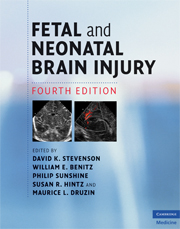Book contents
- Frontmatter
- Contents
- List of contributors
- Foreword
- Preface
- Section 1 Epidemiology, pathophysiology, and pathogenesis of fetal and neonatal brain injury
- Section 2 Pregnancy, labor, and delivery complications causing brain injury
- Section 3 Diagnosis of the infant with brain injury
- Section 4 Specific conditions associated with fetal and neonatal brain injury
- 22 Congenital malformations of the brain
- 23 Neurogenetic disorders of the brain
- 24 Hemorrhagic lesions of the central nervous system
- 25 Neonatal stroke
- 26 Hypoglycemia in the neonate
- 27 Hyperbilirubinemia and kernicterus
- 28 Polycythemia and fetal–maternal bleeding
- 29 Hydrops fetalis
- 30 Bacterial sepsis in the neonate
- 31 Neonatal bacterial meningitis
- 32 Neurological sequelae of congenital perinatal infection
- 33 Perinatal human immunodeficiency virus infection
- 34 Inborn errors of metabolism with features of hypoxic–ischemic encephalopathy
- 35 Acidosis and alkalosis
- 36 Meconium staining and the meconium aspiration syndrome
- 37 Persistent pulmonary hypertension of the newborn
- 38 Pediatric cardiac surgery: relevance to fetal and neonatal brain injury
- Section 5 Management of the depressed or neurologically dysfunctional neonate
- Section 6 Assessing outcome of the brain-injured infant
- Index
- Plate section
- References
38 - Pediatric cardiac surgery: relevance to fetal and neonatal brain injury
from Section 4 - Specific conditions associated with fetal and neonatal brain injury
Published online by Cambridge University Press: 12 January 2010
- Frontmatter
- Contents
- List of contributors
- Foreword
- Preface
- Section 1 Epidemiology, pathophysiology, and pathogenesis of fetal and neonatal brain injury
- Section 2 Pregnancy, labor, and delivery complications causing brain injury
- Section 3 Diagnosis of the infant with brain injury
- Section 4 Specific conditions associated with fetal and neonatal brain injury
- 22 Congenital malformations of the brain
- 23 Neurogenetic disorders of the brain
- 24 Hemorrhagic lesions of the central nervous system
- 25 Neonatal stroke
- 26 Hypoglycemia in the neonate
- 27 Hyperbilirubinemia and kernicterus
- 28 Polycythemia and fetal–maternal bleeding
- 29 Hydrops fetalis
- 30 Bacterial sepsis in the neonate
- 31 Neonatal bacterial meningitis
- 32 Neurological sequelae of congenital perinatal infection
- 33 Perinatal human immunodeficiency virus infection
- 34 Inborn errors of metabolism with features of hypoxic–ischemic encephalopathy
- 35 Acidosis and alkalosis
- 36 Meconium staining and the meconium aspiration syndrome
- 37 Persistent pulmonary hypertension of the newborn
- 38 Pediatric cardiac surgery: relevance to fetal and neonatal brain injury
- Section 5 Management of the depressed or neurologically dysfunctional neonate
- Section 6 Assessing outcome of the brain-injured infant
- Index
- Plate section
- References
Summary
Introduction
In this chapter the impact of congenital heart disease and its surgical treatment on the neonatal brain will be discussed. Babies may have congenital cardiac disease as an isolated malformation or may have a heart defect as part of a larger spectrum of abnormalities, which may in turn be associated with a syndrome. In addition, these babies are often profoundly ill, presenting to medical attention on the verge of cardiac arrest with severe hypoxia, hypotension, or both. The treatment of the condition usually involves a trip to the catheterization laboratory or operating room (or both). We therefore have great potential for neurological morbidity, with a combination of possible underlying abnormality of the brain, preoperative, perioperative, and postoperative insults all conspiring to injure the cardiac surgery patient's brain. Despite these problems, the majority of babies do extremely well following heart surgery in the newborn period, although it is important to recognize that many of them will have a subtle neurological deficit if they are compared to the normal population. These are evidenced as cognitive and intellectual impairment, behavioral difficulties, speech delays, etc.. The incidence of major neurological insult postoperatively as manifest by seizures, stroke, coma, or choreo-athetoid movements has fallen to around 2–11% in the current era.
- Type
- Chapter
- Information
- Fetal and Neonatal Brain Injury , pp. 443 - 452Publisher: Cambridge University PressPrint publication year: 2009
References
- 1
- Cited by



